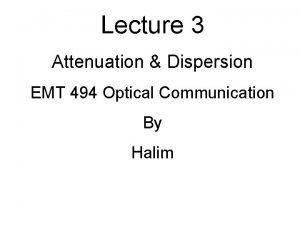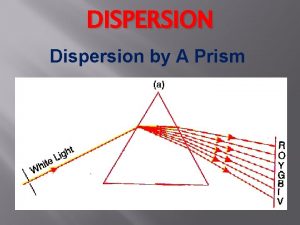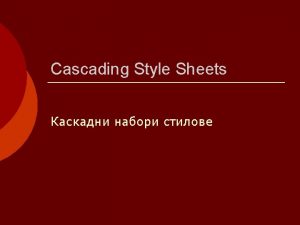Dispersion and prism An important property of the











- Slides: 11

Dispersion and prism An important property of the index of refraction n is that, for a given material, the index varies with the wavelength of the light passing through the material. This behavior is called dispersion. . . Because n is a function of wavelength, Snell’s law of refraction indicates that light of different wavelengths is refracted at different angles when incident on a material. the index of refraction generally decreases with increasing wavelength


refraction by a prism Deviation angle D=i 1+i 2 -A P A D M Minimum Deviation i 1=i 2 , r 1=r 2 i 1 S r 1 S N i 2 r 2 A H Refractive index of prism: If A<< of thin prism , and the incident rays on prism surface: sin i = i , sin r = r D = A (n - 1)

A Graph of the deviation

image formed by refraction of spherical surface n n’ n C F F’ C f f n n’ n’ C ’f n F’ F’ C ’f n’

The relationship between displacement of object and displacement of image that formed by refraction (images formed by refraction ) u v


Flat Refracting surfaces if an object is immersed in a transparent liquid such as water , the image appears closer to the surface. This is a virtual image, once the observer changes his position the virtual image moves closer to the surface. If a refracting surface is flat, then R is infinite and so,

Quick Quiz 36. 4 : what happens to the image point I as the object point O is moved to the right from very far away to very close to the refracting surface? (a) It is always to the right of the surface. (b) It is always to the left of the surface. (c) It starts off to the left, and at some position of O, I moves to the right of the surface. (d) It starts off to the right, and at some position of O, I moves to the left of the surface Quick Quiz 36. 5 : what happens to the image point I as the object point O moves toward the right-hand surface of the material of index of refraction n 1? (a) It always remains between O and the surface, arriving at the surface just as O does. (b) It moves toward the surface more slowly than O so that eventually O passes I. (c) It approaches the surface and then moves to the right of the surface.

A small fish is swimming at a depth d below the surface of a pond (Fig. 36. 20). (A) What is the apparent depth of the fish as viewed from directly overhead? (B) If your face is a distance d above the water surface, at what apparent distance above the surface does the fish see your face?

A set of coins is embedded in a spherical plastic paperweight having a radius of 3. 0 cm. The index of refraction of the plastic is n 1 = 1. 50. One coin is located 2. 0 cm from the edge of the sphere (Fig. 36. 19). Find the position of the image of the coin.
 Dispersed phase and dispersion medium
Dispersed phase and dispersion medium Types of colloids
Types of colloids Signal distortion in optical fiber
Signal distortion in optical fiber Classification of property under hindu law
Classification of property under hindu law Chemical property definition
Chemical property definition From most important to least important in writing
From most important to least important in writing Inverted pyramid in news writing
Inverted pyramid in news writing Least important to most important
Least important to most important What is the most important physical property of alcohol?
What is the most important physical property of alcohol? Associative property vs commutative property
Associative property vs commutative property Circular dichroism and optical rotatory dispersion
Circular dichroism and optical rotatory dispersion Primary dispersion
Primary dispersion





















